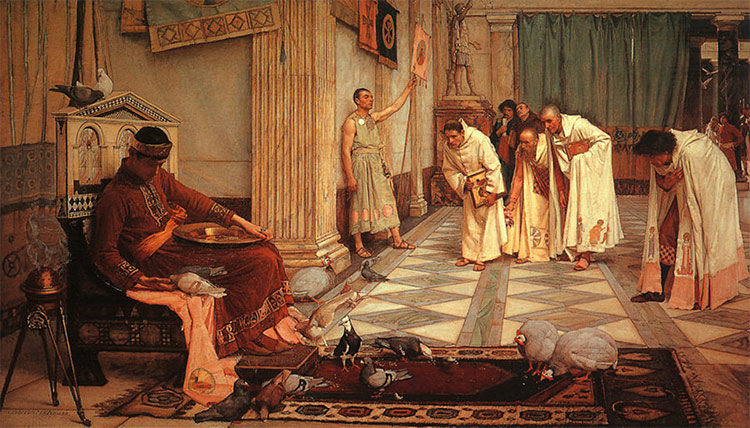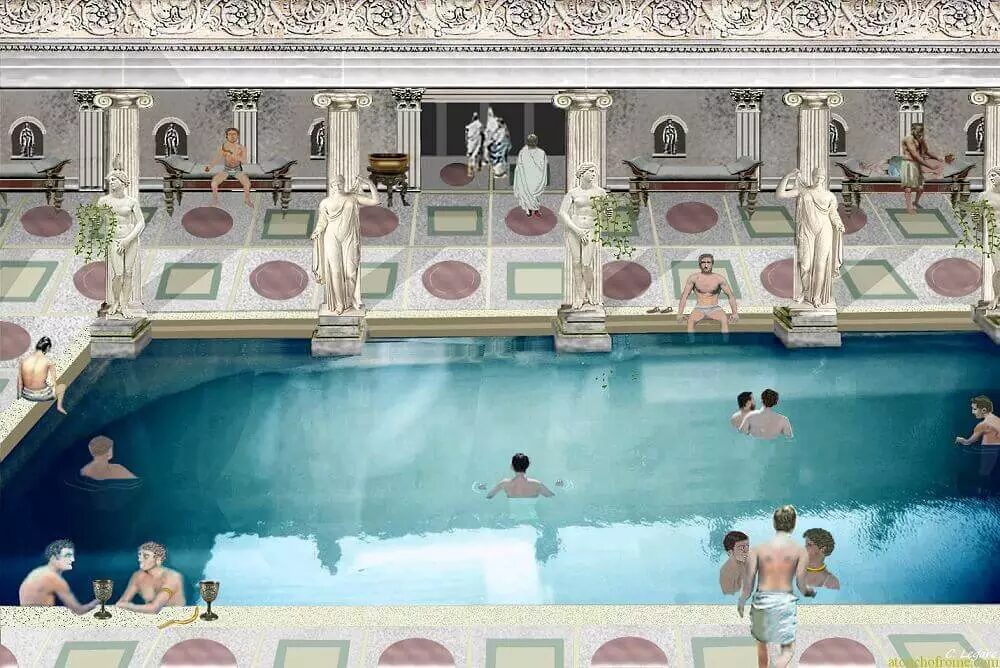Time-traveling to ancient Rome in the year 250 during the tumultuous Crisis of the Third Century is quite the adventure. The Roman Empire is in disarray, struggling with leadership instability, military challenges, and dire economic problems. After arriving in the famous Colosseum, the awe of this extensive arena quickly turns into anticipation for survival in a city facing disorder. The spectacle of gladiator encounters highlights a slice of life in a period when food became scarce, and the empire tried to hold its ground.
Daily life in ancient Rome requires navigating food shortages, public hygiene issues, and persistent threats. Many people face inadequate nutrition due to disrupted trade routes and agricultural problems. Surviving involves understanding Rome’s complex public amenities, like community toilets and public baths, which are cornerstones of Roman social life. Despite efforts to maintain cleanliness, health risks remain high. In these public places, the exchange of goods, ideas, and even disease reflects the broader cultural shifts happening as the empire attempts to endure its challenges.
Key Takeaways
- Daily survival in ancient Rome includes navigating food and health issues.
- The Colosseum provides a glimpse into Roman entertainment and social norms.
- Public baths and restrooms highlight health risks and communal living.
The Challenge of the Third Century
Emperor Severus Alexander’s Demise
In 235, Emperor Severus Alexander‘s rule came to a sudden end. Despite believing peace could be achieved through diplomacy, his decision to pay off Germanic invaders was met with hostility. His own military generals, unhappy about financial resources being redirected, took matters into their own hands. Their dissatisfaction culminated in the assassination of Alexander, leading to power struggles within the empire.
Military Breakdown and Internal Conflict
Following the emperor’s assassination, the Roman Empire’s military strength crumbled. Frequent internal conflicts emerged as new leaders rose and fell. Rival factions within the military fought for control, weakening the empire’s cohesion. This lack of stability allowed regional governors to seize territories and undermined the empire’s ability to defend against external threats.
Economic Upheaval and Prices Soaring
The empire faced serious economic troubles. Agriculture was disrupted, causing widespread food scarcity. Trade routes were unreliable, limiting the distribution of essential goods. To address financial burdens, Roman leaders devalued the currency, which sparked rampant inflation. This devaluation diminished the purchasing power of Roman coins, making everyday life more difficult for its citizens.
Living in Ancient Rome
Roman Eating Habits Amid Crisis
During this tough time, food options grew scarce. The Roman diet usually included a range of fruits, veggies, grains, and some meats. Yet, the crisis made farming difficult, leading to food shortages. Many farms faced issues with either too much or too little water, which harmed crop production. In the face of civil wars, trade routes got disrupted, restricting the movement of supplies. This scarcity especially affected the poor, while the capital could still offer basic bites like greens, figs, and watered-down wine, but for a price.
Troubles in Farmlands
Agriculture faced many hurdles during this period. Some lands went dry while others flooded, leading to fewer successful harvests. Civil wars disrupted trade routes and the transport of goods. These problems hurt supply chains badly, resulting in limited food accessibility, especially for regions far from central Rome.
Money Troubles and Inflation
To address rising debts, Roman leaders decided to lower the value of their currency. They began minting coins with less precious metal content, leading to rapid inflation. This outcome disturbed the economy, raising the price of goods significantly. While people had money, it did not stretch as far as it once did, complicating daily survival.

Visiting the Colosseum
In the heart of ancient Rome, the Colosseum stands as a grand structure. Known for hosting events like gladiator fights and theatre performances, it was a center of entertainment. Over time, the frequency of events declined due to financial struggles within the Roman Empire. During your visit, you may notice fewer events due to defunding and maintenance issues. Still, this remarkable stadium remains a powerful testament to the grandeur of ancient Roman society.
The Colosseum’s atmosphere is unique. Large crowds once gathered to watch intense battles and dramatic plays. The architecture allowed thousands to witness these spectacles from its massive stone tiers. Even with fewer events, the history embedded in its walls is awe-inspiring.
It’s helpful to be prepared if you encounter a local. The people are strong and proud, often speaking in their native Latin language. Although communication might be challenging, gestures and simple phrases can go a long way. Exploring the Colosseum provides a glimpse into the cultural richness and history of ancient Rome.
Arena Confrontation
Rules of Engagement
In this chaotic period, gladiators must be aware of crucial combat rules. For starters, the first strike always aims to be accurate, giving it a cutting edge over the opponent. Following that, the second move finishes with elegance and precision. Mastering these basics in the arena is critical, as every encounter unfolds under the shadow of life-or-death stakes.
Spoils and Endurance
Securing resources is a tough task during this era. The Roman diet features fruits, vegetables, grains, and meats, but an agricultural crisis makes food tricky to source. Unpredictable weather and troubled trade routes add to this scarcity, leading to widespread malnutrition, mainly among the less fortunate. With gold from recent encounters, acquiring essentials becomes possible, though inflation eats away at value. Skill and luck play into navigating conversations and transactions in Latin, even when pointing at desired items.
Public hygiene poses its challenges. Restrooms are simple stone slabs, offering little privacy or sanitation. Lacking modern conveniences, the community shares a single sea sponge for cleaning. Public baths provide some relief with their facilities but suffer from hygiene issues and crowded conditions. Here, strigils, not soap, remove dirt, while scented oils are used for freshening up.
Daily Struggles
Locating and Buying Food
Living in the heart of ancient Rome during a crisis presents its own challenges, especially when it comes to food. The diet typically includes various fruits, vegetables, grains, and meats, but with agriculture upset by war and climate issues, food is in short supply. Bread is available, but choices are mostly greens like cabbage and parsley, and fruits such as figs and grapes. Meat is scarce due to ongoing conflict, making it difficult to find. Inflation adds to the problem, as the currency has been devalued, impacting buying power. Locals and newcomers alike must creatively manage their limited resources.

Embracing Local Food
Adapting to Roman cuisine can be tough if you’re not familiar with it. The ingredients might differ from what’s common today, and language barriers make ordering tricky. Without a grasp of Latin, pointing becomes the most reliable way to buy food. Roman meals often consist of simple items such as bread and watered-down wine, which were standard staples. Adjusting takes time, but the key is flexibility and a willingness to try new items, no matter how unfamiliar they may seem.
Cleanliness and Health in Ancient Times
Public Washrooms and Hygiene Habits
In ancient Rome, public washrooms were known for their less-than-pleasant conditions. They featured several holes carved into marble slabs for communal use. Often situated near public baths, the excess water would help flush waste into the sewer system. However, this did not guarantee cleanliness, and waste buildup was a significant issue. Affluent individuals could afford private bathrooms, but others made do with sharing the facilities and the infamous communal wiping tool—a sponge on a stick. This was cleaned in a shared trough, but hygiene was hardly optimal.
The Odor of Illness
The public baths, known as thermae, were more than just places to get clean. They were social hubs, offering exercise areas, steam rooms, and even libraries. Despite their many uses, the lack of proper cleaning and soap made hygiene a challenge. Romans used a tool called a strigil to scrape off dirt, followed by scented olive oils to mask odors. Though the baths were popular and essential to Roman social life, the stagnant and frequently used waters questioned the actual purity achieved.
Communal Bathhouses
Large Bathing Facilities
In ancient Rome, bathhouses were popular spots for relaxation and socializing. These complexes, referred to as thermae, were full of features. They included areas for exercise, steam rooms, and sometimes even libraries. People gathered here not only to clean themselves but also to catch up with friends and acquaintances.
Visitors often used a tool called a strigil, made of bronze, to scrape dirt and grime from their bodies since they didn’t use soap. After the cleaning, they applied fragrant olive oils to smell pleasant. Though these public baths offered a unique experience, cleanliness was a concern due to frequent usage without regular cleaning.
Bathing Habits and Cleanliness
The practice of bathing in Rome was a blend of hygiene and social activity. The baths were welcoming places where many Romans would come to enjoy the facilities and interact with others. Despite their popularity, the pools were sometimes less clean because of stagnant water and the lack of thorough maintenance.
Romans first visited several warmer rooms to sweat and cleanse their skin, followed by a cool plunge pool to refresh. This ritual was not just about getting clean but also about relaxation and social interactions. A shared sense of community was part of what made these bathhouses central to Roman daily life.

Changes in Society
Believers and Dressing Conservatively
In ancient Rome, clothing styles were influenced by cultural and religious shifts. During this time, many Christians started advocating for more conservative attire. They believed that modesty was an essential part of their faith, and they encouraged covering up more compared to typical Roman fashion trends.
Fashion Practices:
- Tunics: Often made shorter by Romans, Christians preferred longer tunics reaching the knees or even the ankles.
- Togas and Stolas: While togas were common among Roman men, Christian men opted for simpler designs. Women’s stolas became less revealing.
- Head Coverings: Women sometimes wore head coverings, emphasizing modesty.
In the larger Roman society, these shifts seemed unusual, leading to some ridicule. However, these changes were important to Christians, who felt strongly about representing their beliefs in how they dressed. This divergence highlighted the growing cultural distinctions within Roman society.
